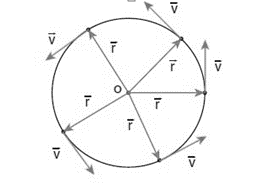
Draw the velocity vector of a body in uniform circular motion.
Answer
122.7k+ views
Hint: Since velocity is a vector, it depends on direction as well as magnitude. So, in circular motion the velocity of the object will change at every point in a direction which is perpendicular to the radius vector as shown below in the diagram.
Complete step by step solution:
Uniform circular motion is a motion in which any object moves with a constant speed. When a body moves in a uniform circular motion, it moves with a constant speed but, at every point its direction changes due to the tangential force. So, the velocity of the body, which is a vector, depends on both magnitude of the speed as well as the direction of motion. The velocity vector is perpendicular to the radius vector in a circular motion. The acceleration that changes only the direction of velocity of the body is called centripetal acceleration.


So, at every point it forms a tangent to circle as shown in the figure above. Therefore, when an object is traversing in a uniform circular motion, the velocity vector forms a tangent to the circle and the direction of velocity changes even though the object is moving with a constant speed.
Note: The accelerating object is undergoing uniform circulation motion and it is mainly due to its change in the direction and is moving to the tangent of the circle. According to Newton’s second law, the direction is always inward and net force is always directed towards the centre of the circle as the acceleration is also in the same direction.
Complete step by step solution:
Uniform circular motion is a motion in which any object moves with a constant speed. When a body moves in a uniform circular motion, it moves with a constant speed but, at every point its direction changes due to the tangential force. So, the velocity of the body, which is a vector, depends on both magnitude of the speed as well as the direction of motion. The velocity vector is perpendicular to the radius vector in a circular motion. The acceleration that changes only the direction of velocity of the body is called centripetal acceleration.


So, at every point it forms a tangent to circle as shown in the figure above. Therefore, when an object is traversing in a uniform circular motion, the velocity vector forms a tangent to the circle and the direction of velocity changes even though the object is moving with a constant speed.
Note: The accelerating object is undergoing uniform circulation motion and it is mainly due to its change in the direction and is moving to the tangent of the circle. According to Newton’s second law, the direction is always inward and net force is always directed towards the centre of the circle as the acceleration is also in the same direction.
Recently Updated Pages
The ratio of the diameters of two metallic rods of class 11 physics JEE_Main

What is the difference between Conduction and conv class 11 physics JEE_Main

Mark the correct statements about the friction between class 11 physics JEE_Main

Find the acceleration of the wedge towards the right class 11 physics JEE_Main

A standing wave is formed by the superposition of two class 11 physics JEE_Main

Derive an expression for work done by the gas in an class 11 physics JEE_Main

Trending doubts
JEE Mains 2025: Check Important Dates, Syllabus, Exam Pattern, Fee and Updates

JEE Main Login 2045: Step-by-Step Instructions and Details

Class 11 JEE Main Physics Mock Test 2025

JEE Main Chemistry Question Paper with Answer Keys and Solutions

JEE Main Exam Marking Scheme: Detailed Breakdown of Marks and Negative Marking

JEE Main 2023 January 24 Shift 2 Question Paper with Answer Keys & Solutions

Other Pages
JEE Advanced Marks vs Ranks 2025: Understanding Category-wise Qualifying Marks and Previous Year Cut-offs

NCERT Solutions for Class 11 Physics Chapter 1 Units and Measurements

NCERT Solutions for Class 11 Physics Chapter 9 Mechanical Properties of Fluids

Units and Measurements Class 11 Notes: CBSE Physics Chapter 1

JEE Advanced 2025: Dates, Registration, Syllabus, Eligibility Criteria and More

NCERT Solutions for Class 11 Physics Chapter 2 Motion In A Straight Line




